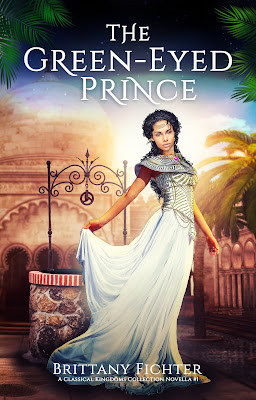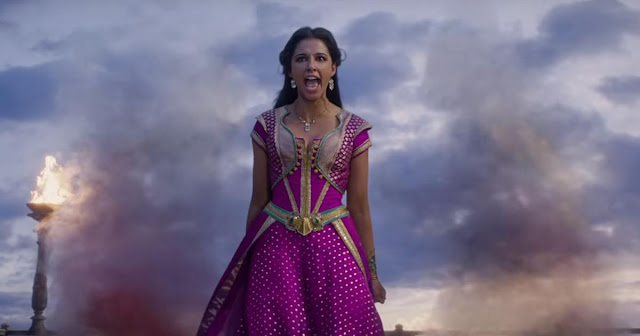Review: The Green-Eyed Prince
About a week ago, Brittany Fichter temporarily released her novella, The Green-Eyed Prince, for free on Amazon Kindle. Not wanting to pass up a good deal, I decided to check it out. You might recognize her name from my reviews of The Autumn Fairy and Silent Mermaid. At this point, I would still say that The Autumn Fairy is my favorite Brittany Fichter book. The Green-Eyed Prince is a retelling of "The Frog Prince" set in the world of her Classical Kingdoms Collection. Since it's a novella, it was much shorter than the other books she's written, but the exotic names and made-up words she used to create a new culture took some getting used to. Overall, I found it enjoyable, but not outstanding.
The Green-Eyed Prince is told from the perspective of a woman named Kartek. Kartek is the "jahira" of her tribe, which I understood to be her culture's version of a princess. She has the ability to heal the sick using a magical jewel that she inherited from her mother. When she learns that her fiancé was murdered and her kingdom is in turmoil, she panics and accidentally drops the enchanted relic down a well in a moment of clumsiness. A mysterious loose-limbed man with piercing green eyes offers to retrieve it for her in exchange for agreeing to become his wife. Kartek is torn. She knows she needs the jewel to help her people, but as the jahira, whoever she marries will affect her entire kingdom. She reluctantly agrees. Over time, she learns more about the person she married, and her feelings for him grow deeper.
The hardest part about this book for me was keeping track of all the names, tribes, and titles. Brittany Fichter tried so hard to create another culture that it seemed as though there was a language barrier that made the book difficult for a casual read. All of the books I've read by her have a pattern of revealing the customs and cultures of their setting through the context of the characters' actions and dialogue instead of expository explanations. This is something that is generally encouraged for writers to do because the story is supposed about the characters, not the world. Yet, I think that there can be a balance between exposition and dialogue. I would at least like to understand what the characters are talking about when they discuss foreign customs with each other as if it were common knowledge.
It's interesting that many modern interpretations of "The Frog Prince" use the "frog" aspect as a metaphor instead of taking it literally like in the fairy tale. Melanie Cellier did this in her adaptation as well. In both A Midwinter's Wedding and The Green-Eyed Prince, the prince's curse causes him to be deformed in such a way that he resembles a frog but is literally a frog. It does say something about the princesses in these stories if they are ashamed to be seen with a deformed man, as there is far less shame in that than there would be in dining and sharing a bed with an actual frog. The princess from the Brothers Grimm tale was spoiled and narcissistic, so having a princess heroine who is as kind and human as Kartek in The Green-Eyed Prince makes it more believable when she eventually grows to care for the deformed stranger. Her reluctance to marry him is also understandable when she is still mourning the loss of her first groom.
The Green-Eyed Prince is not the strongest fairy tale adaptation I've ever read, but it isn't the weakest either. It builds a complex and believable world of magic and royalty with equal amounts of darkness and light. I would have preferred some more time to learn about the kingdom's customs as well as Kartek's healing powers, but the a novella at half the length of Brittany's other books, so I suppose she thought there would not be enough time for that. The characters were very strong and had interesting backstories that kept the story interesting until the very end. If you are a fan of "The Frog Prince," this is a unique retelling that might be worth looking into.
The Green-Eyed Prince is told from the perspective of a woman named Kartek. Kartek is the "jahira" of her tribe, which I understood to be her culture's version of a princess. She has the ability to heal the sick using a magical jewel that she inherited from her mother. When she learns that her fiancé was murdered and her kingdom is in turmoil, she panics and accidentally drops the enchanted relic down a well in a moment of clumsiness. A mysterious loose-limbed man with piercing green eyes offers to retrieve it for her in exchange for agreeing to become his wife. Kartek is torn. She knows she needs the jewel to help her people, but as the jahira, whoever she marries will affect her entire kingdom. She reluctantly agrees. Over time, she learns more about the person she married, and her feelings for him grow deeper.
The hardest part about this book for me was keeping track of all the names, tribes, and titles. Brittany Fichter tried so hard to create another culture that it seemed as though there was a language barrier that made the book difficult for a casual read. All of the books I've read by her have a pattern of revealing the customs and cultures of their setting through the context of the characters' actions and dialogue instead of expository explanations. This is something that is generally encouraged for writers to do because the story is supposed about the characters, not the world. Yet, I think that there can be a balance between exposition and dialogue. I would at least like to understand what the characters are talking about when they discuss foreign customs with each other as if it were common knowledge.
It's interesting that many modern interpretations of "The Frog Prince" use the "frog" aspect as a metaphor instead of taking it literally like in the fairy tale. Melanie Cellier did this in her adaptation as well. In both A Midwinter's Wedding and The Green-Eyed Prince, the prince's curse causes him to be deformed in such a way that he resembles a frog but is literally a frog. It does say something about the princesses in these stories if they are ashamed to be seen with a deformed man, as there is far less shame in that than there would be in dining and sharing a bed with an actual frog. The princess from the Brothers Grimm tale was spoiled and narcissistic, so having a princess heroine who is as kind and human as Kartek in The Green-Eyed Prince makes it more believable when she eventually grows to care for the deformed stranger. Her reluctance to marry him is also understandable when she is still mourning the loss of her first groom.
The Green-Eyed Prince is not the strongest fairy tale adaptation I've ever read, but it isn't the weakest either. It builds a complex and believable world of magic and royalty with equal amounts of darkness and light. I would have preferred some more time to learn about the kingdom's customs as well as Kartek's healing powers, but the a novella at half the length of Brittany's other books, so I suppose she thought there would not be enough time for that. The characters were very strong and had interesting backstories that kept the story interesting until the very end. If you are a fan of "The Frog Prince," this is a unique retelling that might be worth looking into.












Comments